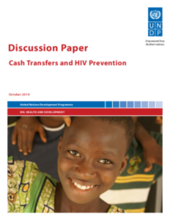This paper from the United Nations Development Programme (UNDP) offers some recommendations on optimizing cash transfers in order to have the greatest impact on those affected by HIV/AIDS. The recommendations include targeting that focuses on communities with high rates of new infections, reduces economic inequalities between men and women, focuses on periods and contexts of high risk (particularly for girls and young women), maximizes cost-effectiveness without compromising people’s privacy, and addresses multiple dimensions of vulnerability.
From the Executive Summary:
“Purpose, scope, intended audience and structure
This discussion paper synthesizes the evidence for the effectiveness of cash transfers for HIV prevention and explores implications and opportunities for advancing research and policy agendas. Much of this evidence centres on girls and young women, who bear significant HIV burdens, particularly in sub-Saharan Africa, and often have less control over their sexual choices than do men. Many forms of transfers exist that may contribute to HIV prevention. These include in-kind transfers such as food transfers, supply-side cash transfers given to health service providers to encourage uptake of services, and vouchers/monetary rewards to reinforce healthier behaviours among people who inject drugs (i.e. contingency management). This paper focuses only on demand-side cash transfers that have the potential to prevent sexual transmission of HIV, which accounts for the greatest share of new infections. The intended audience is policymakers, programme managers and researchers, especially those who are considering building or modifying cash transfer programmes to maximize HIV and health benefits.
Background: Cash transfers in the context of HIV, health and development describes why exploring cash transfers’ potential for HIV prevention is critical and timely, both for HIV and for development more broadly.
Chapter 1: Conceptual framework outlines a conceptual framework for understanding structural drivers of HIV.
Chapter 2: State of the evidence summarizes the empirical evidence for cash transfers in accordance with the conceptual framework.
Chapter 3: Issues, concerns and limitations describes important issues in programme design that can influence the effectiveness of cash transfers and explores some concerns and limitations of cash transfers, both generally and for HIV prevention more specifically.
Chapter 4: Discussion codifies what is known regarding cash transfers and HIV prevention, highlights unresolved issues and offers strategies for moving forward in terms of policy and programmes as well as research.
Conclusion recaps the paper’s high-level themes and messages and offers thoughts on future work.”

